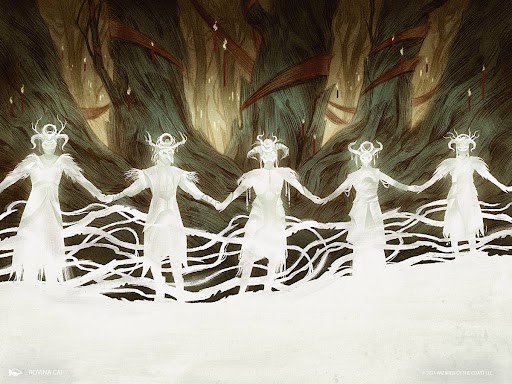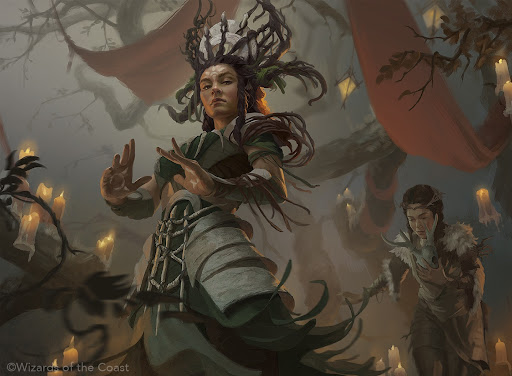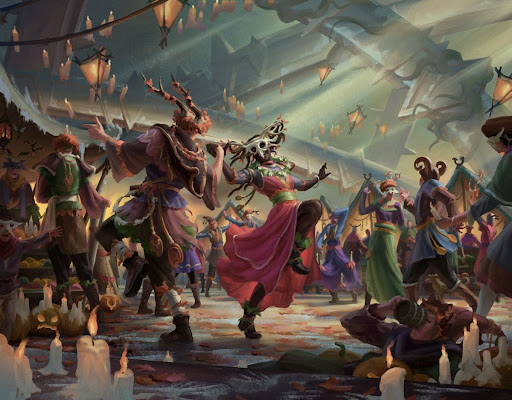Cover image: Path to the Festival by Darek Zabrocki
“A ritual centers the community and its traditions. Over time, hundreds add their faith to its power…”
—Katilda, to Arlinn, “Episode 1: The Witch of the Woods,” by K. Arsenault Rivera.
As I write, it is almost Hallowtide, a sequence of three Catholic and Anglican religious holidays remembering, celebrating, and praying for the dead. Faithful practitioners will prepare by writing deceased loved ones’ names in the Book of the Names of the Dead, and celebrate by attending masses and visiting cemeteries and baking special breads. Of course, this is not what most of us think of when we think of these days. Halloween, the beginning of these three days, and Día de Muertos, the last, are certainly more common associations, with their festive macabre aesthetics. Frightening stories, outlandish costumes, and morbid imagery have historically led many protestant Christians to allege that the festival is more pagan than pious.
Whether or not these allegations are true is complicated, as it turns out. Halloween, as it is popularly celebrated, is a blended development of hundreds of years of folk traditions. The holiday developed in Europe and the Americas by making use of whatever spiritual traditions were available, and Christians and Neo-pagans have each rightfully claimed these as their own, though sometimes with dubious warrant or motives. This syncretic development of the traditions of Hallowtide is a clear referent for Midnight Hunt’s setting at Harvesttide: the restoration of a spiritual harvest festival to ward off the night, attended by Church officials and layfolk with a central ritual performed by the Dawnhart Coven.

Rite of Harmony by Rovina Cai
This essay explores how the story of Midnight Hunt deals with the notion of reclamation and reconstruction of “old ways,” with a view toward how contemporary pagans and Christians do this with Halloween. It’s my contention that Midnight Hunt’s story, on cards and in its short fiction, presents a remarkably nuanced picture of this issue despite it being more a part of the setting than the plot. Furthermore, this nuanced position, as we know it now, points toward a laudable coming-to-terms between Christians and European pagans in dialogue, and manages to paint both in-game faiths as real and positive forces in the lives of Innistrad’s humans.
Returning to the Might of the Old Ways
“The Archangel distracted us from these traditions. We must return to them—to Harvesttide.” (Katilda, to Arlinn)
Before Sorin Markov created Avacyn, there was no organized church structure on Innistrad. Like pre-Christian Northern Europe, Innistrad was a land where the spiritual and even practical needs of the people were ministered to by witches and sages versed in folk magic and nature rituals. As the Planeswalkers Guide has it, these spiritual authorities organized themselves into covens and druidic cults, though there were also many solitary practitioners who lived as hermits by choice or because they were made outcasts.
As faith in Avacyn waxed, so did her effectiveness, and the people’s reliance on the subtle ways of the old magic waned. Covens all but disappeared. An organized Church grew up to administer the new, faith-based magic and to guard the secrets of Avacyn’s origins. With Avacyn gone, the Church and the people are in the midst of a spiritual and existential crisis. Some have turned to Sigarda, saying fervent prayers for her aid and protection, while others have begun to return to the old ways, the hedge magic of their ancestors, in hopes of warding off the creatures of the night. Many others do both, blending their familiar faith in the angel with the ancient magics, a syncretic expression of spirituality common in the real world as well.
In our world, however, contemporary reconstructionist pagans are faced with a problem: nearly every account of the “old ways” are filtered through a Christian lens. Regretfully, very little of Northern European folk religion survives that has not been filtered through Christianity in some fashion. This “filtering” tended to happen in two ways. First, as Christianity spread north in late antiquity, missionaries were often content (even instructed) to leave many pagan holy sites and pious practices intact, incorporating the religious sensibilities of the local people into that area’s manner of Christian observance.
Second, many of these traditions were oral, and were not written down until Christian monks, writing histories or letters, described them—oftentimes long after Christianity had established itself in the area and had already begun influencing or blending with the local spiritual traditions. As a result, it is unclear where paganism ends and Christianity begins. Returning to old ways is almost akin to archaeology, or other fields of historical research, in which the past has to be carefully sifted and interpreted through not only our own biases but the biases of ancient times.

Dawnhart Mentor by Fariba Khamseh
Innistrad, however, has the benefit of being a fictional world where the supernatural often manifests in more predictable (even scientific) ways than what we might expect from our religious traditions. In their process of reviving the ancient ritual of Harvesttide, the Dawnhart Coven didn’t have to pore over ancient texts preserved in the dusty archives of a decrepit chapel—they instead called upon the spirit of Kurbis, one of the first Harvesttide Sovereigns (whose name, humorously, means “pumpkin” auf Deutsch), fusing it with a tree so they could learn directly from this ancient celebrant how the ceremony should be performed.
As Paige Smith hints at in her article, “Folk Horror and Innistrad: Midnight Hunt,” Kurbis, Harvest Celebrant embodies the liminality of Harvesttide and even our Hallowtide in multiple ways. As a reanimated geist inhabiting a tree, it represents, through its first-hand knowledge of the ancient traditions, the perseverance of mysterious rituals. As Smith notes, this perseverance of bygone customs is the very bedrock of folk horror: some traditions are better left in the past. Furthermore, as a treefolk, Kurbis finds itself with new desires to absorb lifeforce; how long will it resist its oaken instincts?
Higher Powers, Greater Goods
Whether the ancient celebrant gives in to its deciduous desires and goes on a coniferous rampage, we are not told. We are left only to speculate what might happen if a careless wanderer trips over the wrong root. Not all encounters around the Harvesttide are so freighted with horror, however. The encounter between Arlinn and Katilda in “The Witch of the Woods” is not merely an encounter between characters. It’s also an encounter between persons of different faith traditions. Katilda found belonging among the hedge witches of the Natterknolls when her own town, Avabruck, was destroyed. Arlinn, likewise, finds herself on the outskirts of human society, cast out of the Church of Avacyn after losing control and mauling devil and cathar alike during a fierce battle, yet persevering in her faith in the power of the angels and in the people of Innistrad.
When Katilda blames Avacyn for turning people away from old rites, Arlinn clearly bristles, but opts to let the polemics slide: there are more important things at stake than whatever Katilda thinks of her faith tradition.
“We must save each other,” Katilda says. And Arlinn had once said something similar to Rembert, the very cleric who had once driven her from the Church. “Avacyn is gone. We must find strength in each other.” It’s here, in this moment of urgency and restraint and openness, that Katilda and Arlinn model something admirable: conversation.
It isn’t that Katilda and Arlinn agree—it’s very clear that Arlinn has reservations, and not just about the way Katilda sees Arlinn’s faith. The Harvesttide festival at the Celestus is dangerous; it is almost certainly doomed to fail without the support of not only the coven of witches and sympathetic laypeople, but also that of cathars and Arlinn herself. But theological disputes can wait when lives are on the line.
Of course, lives are on the line. While our real-world Christian and pagan festival traditions at Hallowtide remember the dead and stare with eyes full of hope toward and beyond the darkness of winter, Innistrad’s Harvesttide has an additional function: keeping the encroaching night from taking over completely. In a manner almost reminiscent of Zendikar Rising’s environmental overtones, Midnight Hunt sees the survival of life on Innistrad threatened by the prospect of eternal night, and calls its protagonists to put aside their old prejudices and work together to restore day and night to their proper balance. These urgent narrative purposes evoke calls from the pope and other faith leaders for persons of good will to work together across religious boundaries for the good of the world, and the work of Christians and pagans in the UK on interfaith dialogue and collaboration, especially on environmental issues.

Celebrate the Harvest by Eelis Kyttanen
Walking the Path to the Festival
In sum, the story of Midnight Hunt does at least two salutary things. First, it gives us another character whose faith is something other than a punching bag. Arlinn Kord is a character whose faith is integral to who she is. Every episode of Rivera’s story that features Arlinn features some reference to faith or religion or prayer because the grammar of faith is part and parcel to how Arlinn thinks and acts. In addition, Arlinn’s faith is mature. In a world where angels and demons engage in spiritual warfare in plain sight, where forgotten deities lurk under the ground, and where religion has served as both a means of control and as a legitimate conduit of protective magic; the temptation to view religious matters cynically, or transactionally, might be even greater than in our world, where cynicism and transactional spirituality can be found in abundance. With Arlinn, we see the values, language, and practices of her faith transcend any mere reliance on angels to help the people, or the power they grant for people trained to harness it, and certainly the social status that comes from being a cathar. Her spirituality is genuine, and oriented toward greater goods.
Second, we see two authentic spiritual traditions, based on real-world religious expressions, coming together to celebrate a festival with a real-world equivalent, written in a manner that is respectful toward the notion that people have religious faith and that this is more than just naivete or an exploitable plot point. Furthermore, Rivera nods to the real-world tensions that exist between Christianity and forms of reconstructionist Paganism in a way that offers a constructive vision of what interfaith collaboration might even look like in the face of real world challenges, such as climate change. This is a positive step for Magic: the Gathering story, and I look forward to see what K. Arsenault Rivera has in store for us next.
Recommended Media:
Doug Beyer and Ari Zirulnik, “Planeswalkers Guide to Innistrad: Midnight Hunt.”
Scott E. Hendrix, “The Pursuit of Witches and the Sexual Discourse of the Sabbat,” Antropologija 11.2 (2011).
Andrew Mark Henry, Religion for Breakfast, History of Halloween: Pagan or Christian?
Kimberly J. Kreines, “The Archmage of Goldnight.”
Sabina Magliocco, Witching Culture (U Penn Press, 2004)
Angela Puca, Angela’s Symposium, “Samhain or Halloween?”
Angela Puca, Angela’s Symposium, “Paganism vs. Christianity ft. Jennifer Uzzell.”
K. Arsenault Rivera, “Episode One: The Witch of the Woods.”
Jacob Torbeck is a researcher and instructor of theology and ethics. He hails from Chicago, IL, and loves playing Commander and pre-modern cubes.

